This is a USDA PDF file from here:
https://www.nass.usda.gov/Charts_and_Maps/Crop_Progress_&_Condition/2019/US_2019.pdf
Since it ships as a PDF, it’s not easy to just pull out an image. It also constantly updates over time. So, OK, I saved a copy today and I’ll grab screenshots of the bits I want to talk about. For better image quality check the original (at least until it changes again).
So I’ve used ‘scrot’ to do screen shots then GIMP to chop out the graphs and make them into png files. Next we’ll look at the crops in no particular order (i.e. not the alphabetical in the original, but more the order that I think has the most information up front).
First up, I’m going to show Barley and Oats. Why? Well, not because we eat a lot of them, but more so that you can see just how short a season they need. They are grown in “high cold places” with short seasons for just that reason.
Barley & Oats
Notice the green “growing season” block runs from June to 3 weeks into August. That’s short. Similarly Oats below, run from last week of May into the start of August. As soon as the ice melts, oats germinate. About the freezing point is all they need.
So the first big takeaway from these graphs is that we CAN grow something to eat with a growing season that is only the center of summer and with a cold start. So Don’t Panic! There might be “issues” getting enough High Fructose Corn Syrup to properly rot your teeth from excess soft drinks, but you can still have oats for breakfast and barley soup for lunch. The only wild card being how fast do farmers convert from what they’ve grown for 30 years to what they can grow in the next decades.
Now note the red line for 2019 is a nice harvest and it is already completed.
So where do we grow Barley?
From: https://www.nass.usda.gov/Charts_and_Maps/Crops_County/br-pl.php we get:
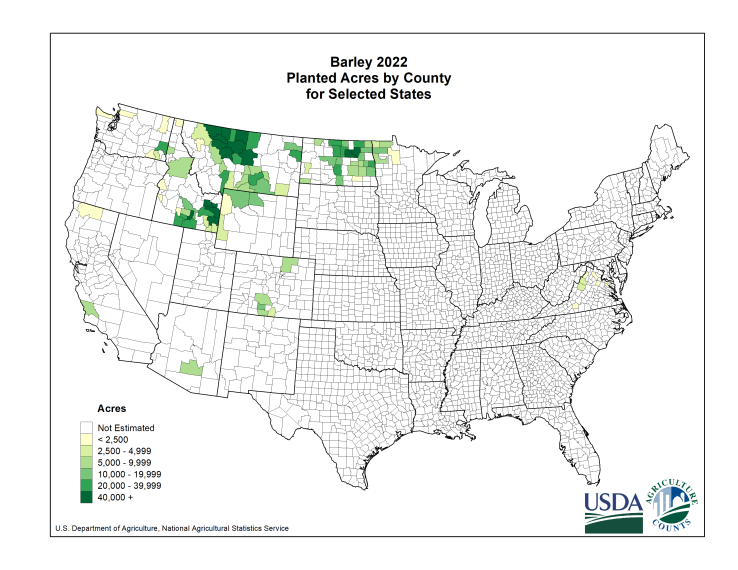
Barley Planted 2018 by County
From: https://www.nass.usda.gov/Charts_and_Maps/Crops_County/ot-pl.php
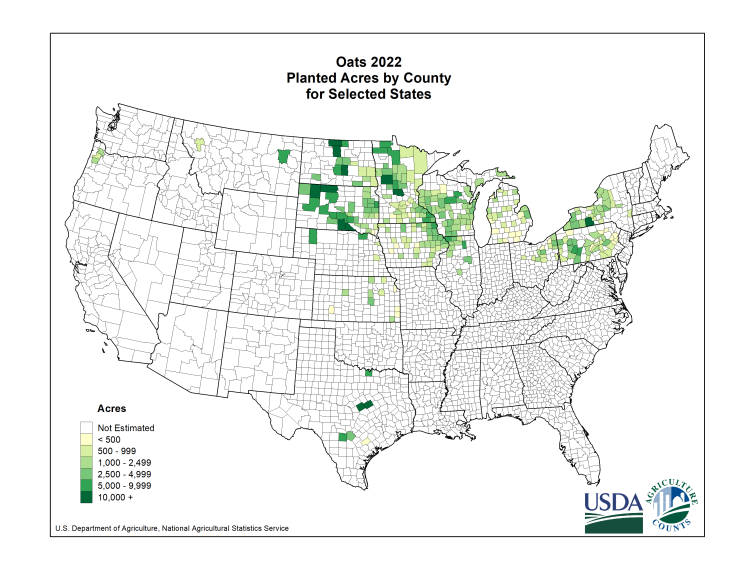
Oats Planting by County 2018
For both, it is largely colder northern places, but do note some is grown in Texas and California. I’d suspect some of that is for seed production away from the general crop areas to prevent varieties crossing, but it just might be someone who really likes those grains. The point being that you CAN grow these cold area crops in warmer areas, and often even in winter instead of being limited to summer crops.
IF things got really bad, we would easily do things like grow more oats and barley “off season” from the usual summer rice in Texas and California. Wind and precipitation being the biggest risks to that strategy. So embrace your inner Scot and pour a bowl of oats!
So much for the good news…
Corn & Soybeans
When I was a child it was thought “risky” to plant a lot of corn north of about the middle of Indiana. Yeah, folks did it, but colder crops were given the edge. As we warmed out of the cold ’70s, the “line of corn” started to march north. Eventually even into the Dakotas and Canada. This was a Very Big Deal and I remember my Dad, from Iowa and corn farming himself, remarking on it being unusual to have corn that far north.
Now, as the Grand Solar Minimum unfolds and our recent Solar Maximum becomes just a fond memory of warmth, the Line Of Corn will need to march south again. Unknown is how many family farms with Grandad’s Stories of growing Barley and Oats instead of corn due to the cold are still remaining…
I grew up in a farm town, and the local Farmers would have breakfast and coffee in our restaurant. As I washed cups and saucers on the other side of the counter, I got to listen to them talking. Farmers have a very long memory for weather and the long duration weather cycles we call “climate”. They also say things like “Sure glad I had that 20 acres of Barley this year, the corn was a bust.” So even just ONE farmer with the old wisdom can get the whole town thinking, and changing. To the extent it is mostly Factory Farms with guys in suits in the city collecting crop insurance checks, well, that’s not going to feed anyone.
So Factory Food wants CORN and SOY and not a lot else. Yeah, some of the other grains end up in feeds, but not much in comparison. Dad fed vealers for 2 weeks on special ordered bags of rolled oats with molasses on them. Then into the freezer. That’s a special beef you will never forget, but you pretty much must grow your own. Not at all like veal, yet not the same as regular old beef either.
But now most of the food in the store is corn / soy fed beef, pork, chickens and “Purina Fish Chow” farmed fish. Then the packaged People Chow is full of soy proteins, soy oil, corn oil, corn in a bewildering variety of forms, and of course tons of High Fructose Corn Syrup. So what happens to corn and soy happens to most of your food supplies.
From: https://www.nass.usda.gov/Charts_and_Maps/Crops_County/ for all the images of plantings:
You can pretty much see that all the Midwest, down the Mississippi, and parts of The South are corn and soybeans. That’s the big deal.
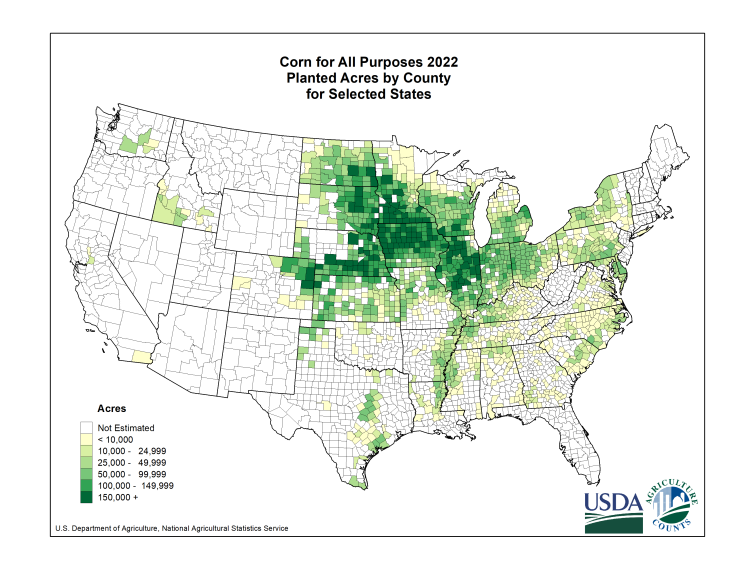
Corn by County 2018
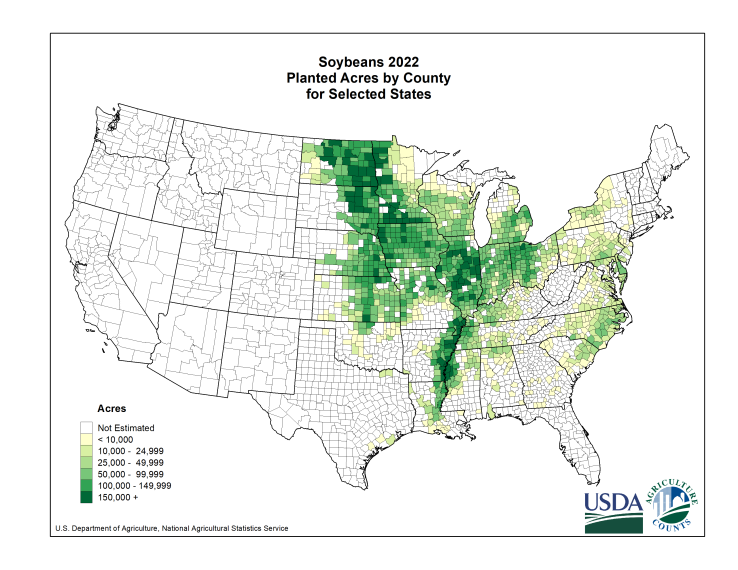
Soybeans by County 2018
So how’s that crop doing? First off, notice how LONG that green growing season is, and how far into fall it runs. These are not fast crops. We’ve gotten much greater yields per acre than in the past, partly by developing slow corn that keeps growing longer and turning more sun into sugar. It will be important for farmers to start moving toward faster varieties again, even if the nominal yield is a bit lower. 100% of 90% is better than 0% of 110%…
Now look at those red 2019 quality lines. The crop is crappy. Only about 1/2 of is good or better. Though not covered in this article, yields are down, where they have harvested, and a lot will not be harvested. Notice that harvested line on the right is well below the dotted last year status, and for corn about 50% / soybeans 70%. It has already frost killed and snow buried a lot of the stuff not yet harvested… You can also see at the far left that the crop went in later than last year and developed later, also not good.
To say this is a “bad thing” is grossly understating it. This isn’t going to just impact canned corn, but pretty much every meat source (other than grazed cattle, lamb, and wild fish) along with most processed foods (i.e. even the ketchup and sodas use corn sugar).
While yes, in the long run we can plant oats, barley, buckwheat and more in those areas instead of corn, in the short run we have to eat and THE biggest supply to our food system is taking a 50% hit. (As a mix of quality, quantity, etc.) Then in the medium term you can’t harvest oats with a corn picker. It takes time to tool up for different crops, and for the local grain merchants to set up to buy them. Change will happen first at the edges of places that already grow alternative crops, but likely not until the 3rd year of this.
The Rest
I’m not going to put up maps for the rest. If you want to see them, hit the link just above. Substantially sugar beets are near barley; and sorghum, sugar cane, tobacco & cotton along with peanuts are down south. Rice is along the southern Mississippi, coastal Texas and a spot in California that’s my home turf. Wheat is a mixed bag of Spring Wheat up north from Eastern Washington State, Idaho, Montana and into North Dakota, while winter wheat is more in the west and scattered around really. Probably better to just show the map for it:

Winter Wheat by County 2018
So here’s the current state of the harvest for some of those other things:
Spring Wheat fast and harvested well. So you will have your toast after all ;-)
Winter wheat did well too. Note that due to the very late / failed harvest this year, many places that had a good winter wheat crop last harvest could not plant it for this winter. You can’t double crop and get your winter wheat in, when the corn and soybeans are still standing and then get 2 foot of snow over them. So next year winter wheat is likely to “have issues” at harvest as it wasn’t planted as much this fall. Notice that the green growing band for Winter Wheat starts in end of October… when we still had standing corn in fields.
Related to wheat (as in spread on it), we have peanuts.
Peanuts, being only really grown in a small warm corner of the South, did fine. So PB on Toast; not so much bacon and eggs… that depend on corn and soy meal. It does look like quality has taken a hit, likely from the wet warmth during the season promoting fungi and molds.
Rice has done well. No real surprise there as it is only grown where it’s warm. So forget the Corn Pops and plan on Rice Checks for breakfast…
Then these last two kind of surprise me. Seems Sunflower is mostly grown in the Dakotas (though I’ve seen it here in California, but I guess not enough to really matter). So Sunflower Oil is not going to get us out of the Soybean and Corn oil holes. Only 30% harvested and they’ve got snow cover. Glad I put a couple of gallons of Olive Oil in the stock room ;-)
Then sugar beets are now mostly across the northern states too. California has had sugar beets at least into the ’80s that I know of, but perhaps C&H (California and Hawaii) now sources sugar from elsewhere… So the sugar beet harvest is lagging, but they are sturdy enough to probably not care if harvested frozen.
There’s other crops at the link, but this is already long and covers all the Big Ones.
To me, I’m not seeing a Food Crisis just yet, but there will be higher prices and there will be shortages of some things that depend on low cost plentiful corn and soy feeds. Expect your chicken, egg, bacon and pork prices to rise most. (But from a very low starting point).
There will be plenty of wheat for PB&J sandwiches and toast / pancakes, along with lots of rice instead of that corn casserole. So substitutions are available.
The biggest strain is likely to come in Packaged Processed Foods. Those folks are over the top committed to corn and soy oils, proteins, and syrups. I’m not that worried as I basically don’t eat processed foods (well, unless you consider coffee & Scotch processed ;-) preferring to mostly cook my own from “scratch”.
So for this coming year, changes in what you pay and some of what you have to eat, but not a disaster. Yet.
OTOH, with a very hungry China looking to buy in all the pork and corn / soy it can get, things are going to be very tight for corn and soy on a global basis, and the African Swine Flu will make pork an occasional thing for much of the world for a good long time.
FWIW, I have an Australian Leg-O-lamb in the fridge to cook tomorrow and we have had lamb chops 2 out of 4 days this week. Grazers are not affected by the shortage of feed grains ;-) Besides, Australian Lamb is just wonderfully flavored…


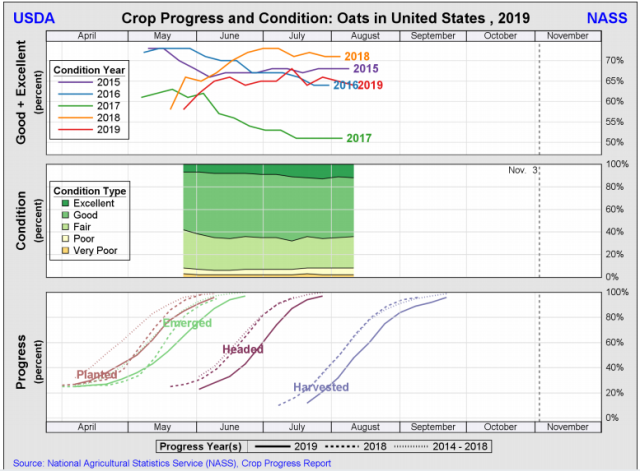








Corn, sorghum, wheat, soybeans, and more, are all grown locally. Sure, cotton is a bigger crop, and this year was pretty good for cotton, if I am not mistaken. Corn and soybeans are, though, fairly big. The county I live in should not be white. Hmm, might be my eyes and the color is too light against a white background. It grows fast and is usually harvested in summer. Wheat gets planted in late winter and usually gets harvested in late spring.
So the question is,, should we invest in Orville Redenbacher?
I see a big demand coming soon! ;-)
Think about that for a minute….
I think I’d rather invest in Bourbon (also corn based)…
Does Bourbon go with popcorn?
Is there anything that doesn’t go with Bourbon or popcorn?
Glad to see you enjoying our lamb, racks are $AUD 43/kg and loin chops $AUD27/kg out here at the moment. Did manage a leg the other day on special at $10/kg, beautiful!
Most of the east coast winter harvest out here is kaput, needed rain to grow, it seems.
Thanks for your amazing work digging around, I always learn from my visits to your site.
“Is there anything that doesn’t go with Bourbon or popcorn?’ -…
What’s the opposite of cornucopia?
Oh I know, _ Alarmist Cli-Sci ‘Thou shalt not-isms.’
No HFCS? If only there was a drink you could make from Barley…
Rhoda: “If only there was a drink you could make from Barley…”
Give me enough time and I’m sure I can come up with something. The main problem is remembering the recipe after drinking the experiments. I’m sure that was a factor that delayed the development of consistent-tasting adult beverages.
What finally got homo sapiens over the hump was the development of writing. That’s when the recipe could be recorded before drinking the experiment. The rest is history ;o)
Rhoda: “If only there was a drink you could make from Barley…”? Is she being facetious? Beer is the answer, and has been for thousands of years. https://www.dummies.com/food-drink/drinks/beer/the-importance-of-barley-to-brewing-beer/
” But you may be surprised to know that cereal grains (not the flakes — the grains) and many other grains can be used to make different kinds of beer. But the cereal grain that lends itself best to beer making is barley.”
Barley wine is a favorite of mine! 8-) Drink for men or gods, Food and libation at the same time….pg
I was looking at the Barley Growing area map and it is a bit misleading. Barley is grown commercially grown everywhere there is commercial farming done. Even near Anchorage and Fairbanks, Alaska. Some Varieties require as little as 60 days of frost free growing season to mature. There are “6 row” Barleys, best for feed and heavy production as well as “2 Row” Barleys that are best for Beer production. The “2Rows” are used for the better quality beer production and are also more cold tolerant to a cool growing season with a cool wet spring. The “2Rows” are more similar to the Emmer Grasses that Wheat was also originated from.
Emmer Wheat: “Emmer is hulled wheat, which means it has strong glumes or husks that enclose the grains. Once the grain is threshed, the wheat spike breaks up into spikelets that require milling or pounding to release the grains from the husks. Other Emmer Wheat Facts. Emmer is also called starch wheat, rice wheat or two-grained spelt”
@P.G.:
Yeah, I was dissapointed in the granularity of the USDA reports. Alaska and Hawaii completly missing? Did they leave the union? Then everthing grows in California somewhere, so clearly they have some kind of percentage threshold, not described, as California is mostly blank or pastel greens. C&H had (has?) a sugar facility near Sacramento and lots of beets grown; but I’ve not observed it in the last decade or 2 so wasn’t willing to claim it still exist. Checking now, at least one is still here:
http://www.spreckelssugar.com
“Spreckels Sugar operates one beet sugar factory located in Brawley, California”
So their map ignores California sugar beets as too small, I guess.
But it covers the biggest bits OK and “good enough for government work.” May even be a feature to leave out the single digit % so you can see the concentration centers.
Alaska grows barley and oats (and more) so leaving it off sucks. They also ignore a lot of crops. Rye, for example. More cold tolerant than wheat. (Why Germans and Slavs had more rye breads than Italians and French – it grew in their cold climate areas). Triticale too. As a wheat rye hybrid it bakes better than rye and grows in cooler places than wheat. Then theirs millet, good in very dry areas and one of the staples of China prior to rice.
So clearly it is not in depth nor precise. Just a snapshot of the few big products in there’s major growing centers. But enough to know there’s trouble in corn and soy country…
If they are filtering on percentage would be nice to have a slider where you could change the cut off for the map so you know exactly what you are seeing.
It is not like dynamic maps are unknown sure a bit more work to set up but once they have the page setup it is just a matter of populating tables with the proper data.
The presented map is one of estimated acreage planted. White is no estimate. Very light yellow is less than 5000 acres (640 acres to the square mile), so maybe won’t count small plots such that 8 square miles was planted in a whole county (mine is roughly 700 square miles, so not a particularly large county) and/or only those planted for commercial purposes.
Over the last 50 years, corn breeding has dramatically improved yields and resiliency. But it looks like someone in Canada has really been pushing the envelope with corn envy.
It is a shorter stature corn and will have a lot less yield than Iowa corn, but just doing it is something. It looks like they mostly market as a grazing crop or for hunting fields.
Still, were I looking for a very fast cold climate corn, it exists!
https://canamaize.com/about-us
They also have a USA site (different ag rules…)
65 to 69 days to a mature feed corn crop? Wow. That’s 2 months range instead of 4.
At least someone is making the choice to develop cold tolerant fast growth varieties.
There are fast sweet corns for fresh eating that do 45 to 50 days, but it takes longer to finish the dough stage and harden dent corn for feed.
I remember a time when 120 days was normal and 75 days was fast for sweet corn…but don’t know what types my dad was planting…
Corn envy? Now there is an opportunity for jokes about, about . . . corn liquor, yeah, that’s it.
Beer indeed is the answer. Whatever the question. And in some theories the cause and reason for civilisation.
Sugar beet? Really? One potential benefits of brexit is the possibility of ditching beet sugar in favour of imported cane sugar. The EU pushes beet as a result of lobbying by producers in North Germany. There is a massive tax on cane sugar. Every autumn in the fens where I used to live the trailers of beet on the way to the processor foul the roadway with mud. The smoke that comes from the processing, a solid mixture of steam and fumes, stinks. I know, I once had a lunatic helicopter pilot fly us through the plume just to see the vortices it made. Wow, did that fill the cabin with stink.
That is the smell of money!
Yeah used to have major sugar beet production here in Colorado but it has pretty well been killed by cheap off shore sugar cane with essentially slave labor.
Sugar is protected with tariffs because it is a strategic commodity (lesson learned by many countries during WWI and WWII). Cheapest source is not always a good idea for essential and critical commodities. That is one of the very bad sides of a globalist view of commerce.
You build into the system critical point failures like just in time delivery and sole source provisions of essential commodities.
Sugar is one commodity that should not be off shore production because then you are putting all your supply eggs in one basket and any issue that takes down your supplier of those commodities or dramatically increases prices suddenly sets you up for massive problems.
I personally have no issue at all with market protections for home producers of critical commodities that have strategic value (aluminum, steel, sugar, oil etc.)
Here in Northwest Maryland the corn is not all in. It was a rough growing season and farmers were still harvesting last weekend.
Hey just wanted to chime in. The Barley region in Alaska is South of Fairbanks near a town called Delta Junction. It has been steadily decreasing in crop size.
https://alaskaflourcompany.com/index.html <: Sell's Alaska grown Barley Flour